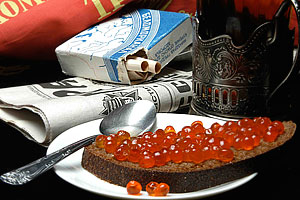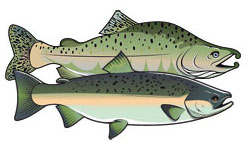 The first writings about grained sturgeon caviar are dated around the 13th century,
when caviar was served exclusively at the tables of royalty. On the other hand,
grained salmon caviar is relatively new to world cuisine. Many sources wrongly cite
the first appearance of salmon caviar back to the 17th century, at the time of the
first Russian exploration of the Far East. In reality, salmon caviar was not utilized
until the early 20th century. Even when active exploration of the Far East was conducted,
the only use for salmon roe was in simply salting the whole egg sack—called a skein—rather
than in grained caviar. The Japanese prepared sujiko, layering roe in skeins on
straw mats to salt them. Salmon skeins were salted like black sturgeon caviar, using
a dry salt method. This product had little demand in Russia and cost 20 kopecks
for 1 slug, which is roughly equivalent to 32 pounds.
Grained salmon caviar, the product that today’s Russians grew up with, was first
used about 100 years ago. Russian ikryanshiki (caviar makers), who traditionally
worked with sturgeon caviar, started producing grained salmon caviar and delivering
it to western Russia. The ikryanshiki used a new method for salting caviar: instead
of using dry salt, they used brine saturated with table salt. Before salting, the
caviar was separated from the skein and rubbed through fine netting called grohot.
The new product was called grained salmon caviar.
In the beginning of the 20th century, there was a high demand for grained salmon
caviar in Japan. The Russian recipe appealed to the Japanese because of its appearance
and taste. Japanese entrepreneurs learned this new method of caviar making and called
it ikura, a word that echoes the Russian word for caviar, ikra. The new ikra was
appealed also to Russians, making salmon caviar a strong competitor to the rare
and expensive black sturgeon caviar.
The first writings about grained sturgeon caviar are dated around the 13th century,
when caviar was served exclusively at the tables of royalty. On the other hand,
grained salmon caviar is relatively new to world cuisine. Many sources wrongly cite
the first appearance of salmon caviar back to the 17th century, at the time of the
first Russian exploration of the Far East. In reality, salmon caviar was not utilized
until the early 20th century. Even when active exploration of the Far East was conducted,
the only use for salmon roe was in simply salting the whole egg sack—called a skein—rather
than in grained caviar. The Japanese prepared sujiko, layering roe in skeins on
straw mats to salt them. Salmon skeins were salted like black sturgeon caviar, using
a dry salt method. This product had little demand in Russia and cost 20 kopecks
for 1 slug, which is roughly equivalent to 32 pounds.
Grained salmon caviar, the product that today’s Russians grew up with, was first
used about 100 years ago. Russian ikryanshiki (caviar makers), who traditionally
worked with sturgeon caviar, started producing grained salmon caviar and delivering
it to western Russia. The ikryanshiki used a new method for salting caviar: instead
of using dry salt, they used brine saturated with table salt. Before salting, the
caviar was separated from the skein and rubbed through fine netting called grohot.
The new product was called grained salmon caviar.
In the beginning of the 20th century, there was a high demand for grained salmon
caviar in Japan. The Russian recipe appealed to the Japanese because of its appearance
and taste. Japanese entrepreneurs learned this new method of caviar making and called
it ikura, a word that echoes the Russian word for caviar, ikra. The new ikra was
appealed also to Russians, making salmon caviar a strong competitor to the rare
and expensive black sturgeon caviar.
 Our product comes from Chum, Pink and Sockeye salmon known for producing superior Red Caviar
Our product comes from Chum, Pink and Sockeye salmon known for producing superior Red Caviar